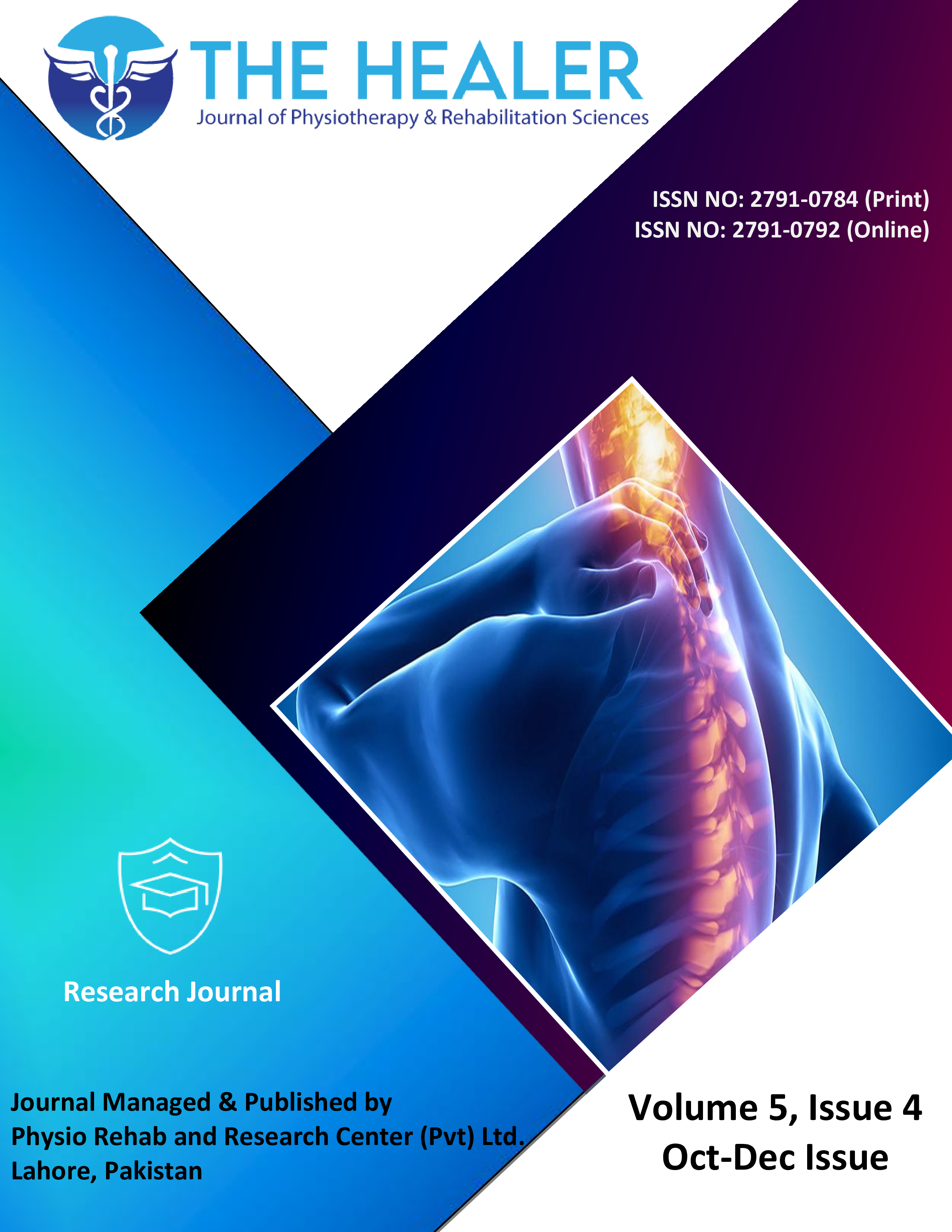Association of Intrascapular Myofascial Trigger Points and Thoracic Hypokyphosis with the Risk of Development of Shoulder Impingement Syndrome: A Cross-Sectional Study
DOI:
https://doi.org/10.55735/91b12g35Keywords:
Myofascial trigger points, Scapular dysfunction, Shoulder impingement syndrome, Thoracic hypokyphosisAbstract
Background: Shoulder impingement syndrome is a frequent musculoskeletal disorder linked to scapular dysfunction and thoracic postural deviations. Intrascapular myofascial trigger points disrupt biomechanics, while thoracic hypokyphosis impairs scapulothoracic rhythm. Objective: To determine the association of intrascapular myofascial trigger points and thoracic hypokyphosis with the risk of developing shoulder impingement syndrome. Methodology: A cross-sectional study was conducted among 176 participants at a physiotherapy clinic in Peshawar from September 2024 to February 2025. Adults aged 20-50 years with shoulder pain lasting at least three months were included. Intrascapular myofascial trigger points were assessed by palpation and pressure pain threshold testing. The thoracic kyphosis angle was measured using a flexible curve ruler and categorized as hypokyphosis (<20°). Shoulder impingement syndrome was confirmed through Neer, Hawkins-Kennedy, and painful arc tests. Data were analyzed using chi-square and logistic regression. Results were expressed as odds ratios with 95% confidence intervals, and statistical significance was set at a p-value less than 0.05. Results: Out of 176 participants, 62 (35.2%) demonstrated thoracic hypokyphosis, and 104 (59.1%) had active intrascapular myofascial trigger points. The prevalence of shoulder impingement syndrome was 46.6% (n=82). Logistic regression revealed that thoracic hypokyphosis (OR=2.14, 95% CI=1.21-3.78, p=0.00) and trigger points (OR=2.87, 95% CI=1.64-5.01, p<0.00) were independently associated with shoulder impingement syndrome. The combined presence of both risk factors showed the highest association (OR=4.12, 95% CI=2.02-8.38, p<0.00). Conclusion: Intrascapular myofascial trigger points and thoracic hypokyphosis are significantly associated with shoulder impingement syndrome risk. Early screening and management of postural and myofascial dysfunctions may help prevent or reduce impingement syndrome in at-risk populations.
Downloads
References
1. Park SJ, Kim SH, Kim SH. Effects of thoracic mobilization and extension exercise on thoracic alignment and shoulder function in patients with subacromial impingement syndrome: A randomized controlled pilot study. Healthcare (Basel). 2020; 8(3): 316.
http://doi.org/10.3390/healthcare8030316 DOI: https://doi.org/10.3390/healthcare8030316
2. Bukhari B, Ali S, Afzal S. Thoracic spinal thrust manipulation for shoulder impingement syndrome: A meta-analysis. Journal of the Pakistan Medical Association. 2025; 75(3): 456-461.
http://doi.org/10.47391/JPMA.11608 DOI: https://doi.org/10.47391/JPMA.11608
3. Bukhari B, Ahmad A, Fatima A, Ali S. Effects of thoracic spinal thrust manipulation for the management of shoulder impingement syndrome: A systematic review. Journal of the Pakistan Medical Association. 2023; 73(2): 338-345.
http://doi.org/10.47391/JPMA.5151 DOI: https://doi.org/10.47391/JPMA.5151
4. Barrett E, O’Keeffe M, O’Sullivan K, Lewis J, McCreesh K. Is thoracic posture associated with shoulder pain, range of motion and function? A systematic review. Manual Therapy. 2016; 26: 38-46.
http://doi.org/10.1016/j.math.2016.07.008 DOI: https://doi.org/10.1016/j.math.2016.07.008
5. Salsali M, Sheikhhoseini R, Sayyadi P, Hides JA, Dadfar M, Piri H. Association between physical activity and body posture: a systematic review and meta-analysis. BMC Public Health. 2023; 23(1): 1670.
http://doi.org/10.1186/s12889-023-16617-4 DOI: https://doi.org/10.1186/s12889-023-16617-4
6. Bakshi NK, Freehill MT. The overhead athlete’s shoulder. Sports Medicine and Arthroscopy Review 2018; 26(3): 88-94.
http://doi.org/10.1097/JSA.0000000000000200 DOI: https://doi.org/10.1097/JSA.0000000000000200
7. Lewis JS, Wright C, Green A. Subacromial impingement syndrome: the effect of changing posture on shoulder range of movement. Journal of Orthopaedic & Sports Physical Therapy. 2005 ; 35(2): 72-87.
http://doi.org/10.2519/jospt.2005.35.2.72 DOI: https://doi.org/10.2519/jospt.2005.35.2.72
8. Waqas MS, Karimi H, Ahmad A, Rafiq S, Anwar N, Liaqat S. The effects of spinal manipulation added to exercise on pain and quality of life in patients with thoracic spinal pain: a randomized controlled trial. BioMed Research International. 2023; 27; 7537335.
http://doi.org/10.1155/2023/7537335 DOI: https://doi.org/10.1155/2023/7537335
9. Strunce JB, Walker MJ, Boyles RE, Young BA. The immediate effects of thoracic spine and rib manipulation on subjects with primary complaints of shoulder pain. Journal of Manual and Manipulative Therapy. 2009; 17(4): 230-6.
http://doi.org/10.1179/106698109791352102 DOI: https://doi.org/10.1179/106698109791352102
10. Haik MN, Alburquerque-Sendín F, Camargo PR. Short-term effects of thoracic spine manipulation on shoulder impingement syndrome: a randomized controlled trial. Archives of Physical Medicine and Rehabilitation. 2017; 98(8): 1594-605.
https://doi.org/10.1016/j.apmr.2017.02.003 DOI: https://doi.org/10.1016/j.apmr.2017.02.003
11. de Oliveira TMD, Felício DC, Filho JE, Fonseca DS, Durigan JLQ, Malaguti C. Effects of whole-body electromyostimulation on health indicators of older people: systematic review and meta-analysis of randomized trials. Journal of Bodywork and Movement Therapies. 2022; 31: 134-45.
https://doi.org/10.1016/j.jbmt.2022.03.010 DOI: https://doi.org/10.1016/j.jbmt.2022.03.010
12. Gerwin R, Dommerholt J, Shah JP. An expansion of Simons’ integrated hypothesis of trigger point formation. Curr Pain Headache Rep. 2020; 24(8): 36.
http://doi.org/10.1007/s11916-020-00869-0
13. Urits I, Charipova K, Gress K. Treatment and management of myofascial pain syndrome. Best Practice & Research Clinical Anaesthesiology. 2020; 34(3): 427-448.
http://doi.org/10.1016/j.bpa.2020.08.003 DOI: https://doi.org/10.1016/j.bpa.2020.08.003
14. Fernández-de-Las-Peñas C, Dommerholt J. Myofascial trigger points: Peripheral or central phenomenon? Current Rheumatology Reports. 2014; 16(1): 395.
http://doi.org/10.1007/s11926-013-0395-2 DOI: https://doi.org/10.1007/s11926-013-0395-2
15. Bron C, Franssen J, Wensing M, Oostendorp RA. Interrater reliability of palpation of myofascial trigger points in three shoulder muscles. Journal of Manual and Manipulative Therapy. 2007; 15(4): 203-15.
http://doi.org/10.1179/106698107790819477 DOI: https://doi.org/10.1179/106698107790819477
16. Demeco A, de Sire A, Salerno A, et al. Dry needling in overhead athletes with myofascial shoulder pain: a systematic review. Sports (Basel). 2024 ;12(6): 156.
http://doi.org/10.3390/sports12060156 DOI: https://doi.org/10.3390/sports12060156
17. Arias-Buría JL, Fernández-de-Las-Peñas C, Palacios-Ceña M, et al. Exercises and dry needling for subacromial pain syndrome: a randomized parallel-group trial. Journal of Pain. 2017; 18(1): 11-18.
http://doi.org/10.1016/j.jpain.2016.08.013 DOI: https://doi.org/10.1016/j.jpain.2016.08.013
18. Heredia-Rizo AM, López-Hervás A, Herrera-Monge P, et al. Shoulder functionality after manual therapy in subjects with shoulder impingement syndrome: a case series. Journal of Bodywork and Movement Therapies. 2013; 17(2): 212-8.
http://doi.org/10.1016/j.jbmt.2012.07.004 DOI: https://doi.org/10.1016/j.jbmt.2012.07.004
19. Fernández-de-Las-Peñas C. Interaction between trigger points and joint hypomobility: a clinical perspective. Journal of Manual and Manipulative Therapy. 2009; 17(2): 74-7.
http://doi.org/10.1179/106698109790824721 DOI: https://doi.org/10.1179/106698109790824721
20. Arjun MV, Rajaseker S. Association between subscapularis trigger point and frozen shoulder: A cross-sectional study. Journal of Bodywork and Movement Therapies. 2021; 28: 406-410.
http://doi.org/10.1016/j.jbmt.2021.06.025 DOI: https://doi.org/10.1016/j.jbmt.2021.06.025
21. Lewis JS. Rotator cuff tendinopathy: a model for the continuum of pathology and related management. British Journal of Sports Medicine. 2010; 44(13): 918-23.
http://doi.org/10.1136/bjsm.2008.054817 DOI: https://doi.org/10.1136/bjsm.2008.054817
22. Goldberg CJ, Moore DP, Fogarty EE, Dowling FE. Left thoracic curve patterns and their association with disease. Spine. 1999; 24(12): 1228-33.
http://doi.org/10.1097/00007632-199906150-00010 DOI: https://doi.org/10.1097/00007632-199906150-00010
23. Fernández-de-Las-Peñas C, Cuadrado ML, Pareja JA. Myofascial trigger points, neck mobility, and forward head posture in unilateral migraine. Cephalalgia. 2006; 26(9): 1061-70.
http://doi.org/10.1111/j.1468-2982.2006.01162.x DOI: https://doi.org/10.1111/j.1468-2982.2006.01162.x
24. Pieters L, Lewis J, Kuppens K, et al. An Update of Systematic Reviews Examining the Effectiveness of Conservative Physical Therapy Interventions for Subacromial Shoulder Pain. Journal of Orthopaedic & Sports Physical Therapy. 2020; 50(3): 131-141.
http://doi.org/10.2519/jospt.2020.8498 DOI: https://doi.org/10.2519/jospt.2020.8498
25. Kim D, Cho M, Park Y, Yang Y. Effect of an exercise program for posture correction on musculoskeletal pain. Journal of Physical Therapy Science. 2015; 27(6): 1791-4.
http://doi.org/10.1589/jpts.27.1791 DOI: https://doi.org/10.1589/jpts.27.1791
26. Gumina S., Di Giorgio G., Postacchini F., Postacchini R. Subacromial space in adult patients with thoracic hyperkyphosis and in healthy volunteers. La Chirurgia degli organi di movimento. 2008; 91: 93-96.
http://doi.org/10.1007/s12306-007-0016-1 DOI: https://doi.org/10.1007/s12306-007-0016-1
27. do Nascimento JDS, Sendín FA, Ferreira LCC de, et al. Immediate Effects of Ischemic Compression Therapy on Myofascial Trigger Points on Pain, Mobility, and Strength in Individuals With Subacromial Impingement Syndrome: A Single-arm Study. Research Square. 2020; 1.
http://doi.org/10.21203/rs.3.rs-55524/v1 DOI: https://doi.org/10.21203/rs.3.rs-55524/v1
28. Park S, Cho J, Lee S. Treatment of myofascial trigger points of the infraspinatus is effective in relieving shoulder pain and improving shoulder functions: A randomized clinical trial. Physical Therapy Rehabilitation Science. 2022; 11: 335-43.
http://doi.org/10.14474/ptrs.2022.11.3.335 DOI: https://doi.org/10.14474/ptrs.2022.11.3.335
29. Xu A, Huang Q, Rong J, Wu X, Deng M, Ji L. Effectiveness of ischemic compression on myofascial trigger points in relieving neck pain: A systematic review and meta-analysis. Journal of Back and Musculoskeletal Rehabilitation. 2023; 36(4): 783-798.
http://doi.org/10.3233/BMR-220045 DOI: https://doi.org/10.3233/BMR-220045
30. Kang NY, Im SC, Kim K. Effects of a combination of scapular stabilization and thoracic extension exercises on forward head posture, pain, and disability in office workers: a randomized study. Turkish Journal of Physical Medicine & Rehabilitation. 2021; 67(3): 291-299.
http://doi.org/10.5606/tftrd.2021.6397 DOI: https://doi.org/10.5606/tftrd.2021.6397
31. Tauqeer S, Arooj A, Shakeel H. Effects of manual therapy in addition to stretching and strengthening exercises to improve scapular range of motion, functional capacity, and pain in patients with shoulder impingement syndrome: a randomized controlled trial. BMC Musculoskeletal Disorders. 2024; 25(1): 192.
http://doi.org/10.1186/s12891-024-07294-4 DOI: https://doi.org/10.1186/s12891-024-07294-4
32. Zanjani B, Shojaedin SS, Abbasi H. Investigating the combined effects of scapular-focused training and Mulligan mobilization on shoulder impingement syndrome: a three-arm pilot randomized controlled trial. BMC Musculoskeletal Disorders. 2024; 25(1): 897.
http://doi.org/10.1186/s12891-024-07966-1 DOI: https://doi.org/10.1186/s12891-024-07966-1
33. Gu Q, Pan L, Yu L, et al. Effect of scapular posterior tilting exercise on scapular muscle activities in men and women with a rounded shoulder posture. Journal of Orthopaedic Surgery and Research. 2024; 19(1): 383.
http://doi.org/10.1186/s13018-024-04810-z DOI: https://doi.org/10.1186/s13018-024-04810-z

Downloads
Published
License
Copyright (c) 2025 The Healer Journal of Physiotherapy and Rehabilitation Sciences

This work is licensed under a Creative Commons Attribution 4.0 International License.














